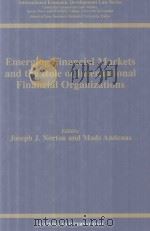《EMERGING FINANCIAL MARKETS AND SECURED TRANSATIONS》
| 作者 | JOSEPH J.NORTON MADS ANDENAS 编者 |
|---|---|
| 出版 | KLUWER LAW INTERNATIONAL |
| 参考页数 | 559 |
| 出版时间 | 1998(求助前请核对) 目录预览 |
| ISBN号 | 9041106758 — 求助条款 |
| PDF编号 | 813696428(仅供预览,未存储实际文件) |
| 求助格式 | 扫描PDF(若分多册发行,每次仅能受理1册) |

1The Changing Nature of Security RightsProfessor Roy Goode1
1 The Importance of Security1
2 The Development of Security Law2
3 The Future of Security Law3
2A Comparative Introduction to Security over Movables and IntangiblesProfessor Dr Ulrich Drobnig5
1 A Unitary Security Interest or Multiple Security Interests?6
2 Formal Requirement for the Security Arrangement7
3 Registration of the Security Interest7
4 Fluctuating Collateral9
5 Global Security11
6 Enforcement of the Securi12
7 Conclusion13
3Economic Functions of Security in a Market EconomyDr Heywood W. Fleisig15
1 Introduction15
2Microeconomic Foundations of Lending16
2.1 The benchmark of an ordinary market.16
2.2 The market for loans.17
2.3 Evaluating promises in the market for loans17
2.4 Unsecured lending17
2.5 Secured lending and secured guarantees18
2.6Secured versus unsecured lending18
2.6.1 Asymmetric information19
2.6.2 Adverse selection and moral hazard19
2.7 Overall assessment21
3Critiques of the Role of Security21
3.1 Interest rates will adjust22
3.2 The pool of risk is irreducible22
3.3 Security simply shifts more risk to the unsecured lenders.23
3.4 Collateral does not change the marginal lending rate23
3.5 Equity and debt are interchangeable at the margin24
4Collateral and Limited Access to Credit24
4.1Macroeconomic problems and high bank intermediation margins25
4.1.1 Macroeconomic risk25
4.1.2 Higher bank spreads and the difficulty of collecting against real estate mortgages26
4.1.3 Risk in taking personal property as collateral27
4.2 Bank disinterest in making small loans27
4.3 Overly restrictive bank supervision30
4.4 Insufficient Savings30
4.5 Absence of public banks and public credit lines31
5The Economic Gain from Reforming the Framework for Secured Transactions32
5.1Qualitative issues33
5.1.1 Efficiency in allocating capital33
5.1.2 Efficiency in the allocation of savings34
5.1.3 Equity, poverty, and access to credit34
5.2 How much does this matter?35
6 Bibliography35
4World-Wide Security — Classification of Legal JurisdictionsProfessor Philip R. Wood39
1 Introduction39
2 Policies of Security40
3 International Divergence40
4 Jurisdictional Classification41
5 Criteria42
6 Title Finance46
7 Conclusion47
5Classifications of Security Interests on the Highways of International CommerceProfessor Oskar Hartwieg49
1 Introduction49
2The Choice-of-Law Aspect as Opening up Legal Issues54
2.1 The ’systemic position’ of civil law54
2.2 The ’practical approach’ in common law55
2.3 Needs for assimilation: world-wide57
3Experiences58
3.1 Displacements of collateral between civil law countries58
3.2 Reservations of title before British law courts62
3.3Collateral imported to the United States66
3.3.1 In re Duplan67
3.3.2 Hong Kong and Shanghai Banking Corp., Ltd. V. HFH USA Corporation69
3.3.3 Summarv on Characterisation73
4Classification: A Clew of Creditors’ Risks in International Trade75
4.1 Substantive law75
4.2 Procedure77
4.3Legal cooperation in international cases79
4.3.1 Rights and remedies79
4.3.2 The law of conflicts79
4.3.3 Motions for decision in procedural matters80
5 Conclusion81
6The Conditional Sale is Alive and Well!Professor J.H. Dalhuisen83
1 Introduction83
2 Conditional Sales and Securities: The Situation Under the New Dutch Civil Code88
3 The Situation in France98
4 The Situation in Germany106
5 The Situation in the UK115
6 The Situation in the US129
7 Finance Sales as Distinguished from Secured Transactions133
8 Conclusion140
7General Principles of a Modern Secured Transactions LawJohn L. Simpson ? Jan-Hendrik M. Rover143
1 Introduction143
2 Purpose of Security and Objectives of Reform144
3Effectiveness of Security Law — Ensuring that Security Achieves its Purpose145
3.1 Essential qualities of the security right145
3.2 Certainty of the security right146
3.3 Means of recovery of the debt from the secured asset147
3.4 Costs of creating, maintaining and exercising the security right148
4Encouraging the Use of Security in the Widest Possible Range of Circumstances148
4.1 Any person may give security over his assets149
4.2 Security may be given to any person to whom the secured debt is owed150
4.3Secured debt150
4.3.1 Security can be given for any present or future debt or debts150
4.3.2 Security may be given for a changing pool of debt151
4.4Assets given as security151
4.4.1 Security can be given over all types of assets151
4.4.2 Security can be given over assets which are acquired subsequently151
4.4.3 Security may be given over a changing pool of assets152
4.5 Use of secured assets153
4.6 General155
Contractual flexibility155
8A Functional Analysis of the EBRD Model Law on Secured TransactionsProfessor John A. Spanogle157
1 What Conduct does Society Seek from a Potential Secured Creditor by Enacting the EBRD Model Law?158
2How Effectively does the EBRD Model Law Induce a Potential Secured Creditor to Give Value for the Collateral?159
2.1 Does it cost a lot to create an enforceable charge?160
2.2 Does it cost a lot to enforce the charge?161
2.3 Does enforcement of the charge provide real commercial value for the creditor?162
2.4 Can potential secured creditors determine, with certainty and at little cost, before the loan is made, whether any other creditor will have a better claim to the charged property?164
2.5 Is the secured creditor protected from the claims of third parties, including other creditors, the trustee in bankruptcy, purchasers and statutory claimants?167
3 How Would the EBRD Model Law System Work in Practice?169
4 Conclusion171
9The Model Law on Secured Transactions of the EBRD from a German Point of ViewProfessor Dr Karl Kreuzer175
1 Introduction175
2Outline of the Present German Law on Secured Transactions and Proposals for its Reform176
2.1 Law in the books176
2.2 Living Law177
2.3 Proposals for a reform179
3Assessment of the EBRD-Model law from a German Point of View179
3.1 Requirements179
3.2Assessment180
3.2.1 General points180
3.2.1.1 Optimal use of the debtor’s assets as security180
3.2.1.2 Right to possession and to use by the party granting security and compensatory securities for the secured party (vertical extension)181
3.2.1.3 Possibility of horizontal extension of the security right182
3.2.1.4 Simple, effective and cheap enforcement of the security for the secured party183
3.2.2 Special problems185
3.2.2.1 Public disclosure185
3.2.2.2 Priorities187
3.2.2.3 Excessive securing188
3.2.2.4 Charges with foreign elements188
3.2.2.5 Article 5.7 MLST as internal law rule?189
3.2.2.6 Article 5.7 MLST as hidden choice-of-law rule?190
3.2.2.7 Recognition of foreign charges191
4Summary and Conclusions192
10The EBRD Model Law and the Hungarian LawProfessor Dr Attila Harmathy197
1 Introduction197
2 The Background199
3Hungarian Conditions to be Considered by Legislation201
3.1Economic actors201
3.1.1 Possible debtors201
3.1.2 Banks203
3.2 Legal Environment205
4EBRD Model Law and the Hungarian Bill on Charges207
4.1 Scope of Regulation207
4.2 The object of the charge208
4.3 Adaptation to the system209
11UNCITRAL’s Work in the Field of Secured TransactionsSpiros V. Bazinas211
1 Introduction211
2 Security Interests211
3Assignment in Receivables Financing213
3.1 The background213
3.2 The problem and the suggested solution214
3.3 Scope of work215
3.4 Possible issues215
3.5 Future work218
12Credit Security and Debt Recoveey: Law’s Role in Reform in Asia and the PacificProfessor Ross Cranston, M.P.219
1 Introduction219
2 The Law’s Context221
2.1Pro-creditor/pro-debtor contexts222
2.2The different dimensions of context223
2.2.1 The economic dimension223
2.2.2 The political dimension224
2.2.3 The culture dimension228
3 Law and its Administration230
4Credit Appraisal232
4.1 The role of lawyers232
4.2 Credit referencing233
4.3 Registration of securi (collateral)234
5Lending Agreements235
5.1 Freedom of contract; interest235
5.2 The terms of a loan236
5.3 Monitoring of the borrower237
5.4 The documentation237
5.5 Legal formalities238
6Security (Collateral)238
6.1 Range of security239
6.2 Extrajudicial enforcement of security240
6.3 Stamp duty and security243
7Law’s Administration243
7.1 Procedural rules243
7.2 The legal culture: lawyers, judges and officials244
7.3 Special debt recovery courts246
7.4 Execution248
8 Conclusions248
13Difficulties in Obtaining Secured Lending in Latin America: Why Law Reform Really MattersAlejandro M. Garro251
1 Introduction251
2 Practical Concerns in Obtaining Secured Credit in Different Financing Scenarios252
3 Regulation of Personal Property Secured Lending256
4 Main Legal Obstacles to Secured Lending256
5 Relationship between Assets-based Secured Lending and the Availability of Credit in Latin America259
6 Relationship between Personal Property Security Law, the High Cost of Commercial and Consumer Credit, and Social Inequality261
7 Why the Inadequacy of the Legal Rules Really Matters262
8 What Kind of Law Reform Efforts are to be Commended?263
9 Efforts of Law Reform at the Domestic Level264
10 Law Reform Efforts at the International Level264
11 Significance of Harmonisation at the Regional Level265
12 Conclusion266
14Selected Security Interests in the United States Professor Peter Winship267
1 A Bit of History267
2 The Single Conceptual Framework268
3Inventory Financing271
3.1 After-acquired property and future advance clauses271
3.2 Proceeds272
3.3 Inventory272
3.4 Priority contests272
3.5 The floating lien in bankruptcy273
3.6 Field warehouses273
4Equipment Financing274
4.1 Equipment leases274
4.2 Equipment as a fixture274
4.3 Accessions to equipment275
4.4 Equipment subject to a certufucate of title275
4.5 Mobile equipment275
4.6 Financing buyer276
5 Financing of Intangibles276
15Mixed Systems: ScotlandProfessor George L. Gretton279
1 Introduction to Scots Law279
2 Introduction to Secured Transactions280
3The Focus of this Chapter: The Culture Gap282
3.1 Immovable hypothecs283
3.2 Securities over corporeal movables284
3.3 Security over incorporeal movables285
3.4 The floating charge286
4 Is Security a Good Thing?290
5 Some Conclusions292
16Security Issues under Russian LawAlexei Zevrev293
1 Brief General Characteristics of Russian Economic and Legal Development293
2 Applicable legislation295
3 Security/Pledge — A Proprietary Right or a Type of Obligation?296
4 Types of Security, their Common Features and Differences296
5 Types of Property/ Proprietary Rights Subject to Charge297
6 Russian Concept of Charge and the Floating Charge Concept298
7Particular Requirements of the Russian Law299
7.1 General principles and protection of rights of pledgor and pledgee299
7.2 Registration of pledges: mortgages300
7.3 Other specific provisions301
8Enforcement301
8.1 Grounds for enforcement301
8.2 Ranking of creditors’ claims:302
8.3 Manners of enforcement302
8.4 Realisation of charged assets303
9 Choice of Law and Enforcement of Foreign Judgments304
17Secured Financing Issues for International Lenders: Bridging the Gap Between the Civil and Common Law through Asset-backed Securitisation — Lessons From and Respecting Argentina and MexicoDavid W. Banowsky ? Joseph J. Norton307
1 Introduction307
2How Legal Restrictions on Collateral Limit Access to Credit in Mexico309
2.1 Commercial credit environment in Mexico309
2.2Legal issues with respect to guaranteed credit transactions — personal property that may be pledged311
2.2.1 Accounts receivable and intangible rights311
2.2.2 ’Floating liens’ (guarantia flotante sobre bienes muebles)312
2.3 Perfection312
2.4 Enforcement313
2.5Selected aspects of Mexican real estate development and practice314
2.5.1 Collateral security for financing314
2.5.2 Practical aspects of Mexican real estate investments315
3How Legal Restrictions on Collateral Limit Access to Credit in Argentina316
3.1 Findings of World Bank mission316
3.2 Economic consequences of the collateral problem and growth318
4Development of Mortgage-backed Securitisatuon318
4.1 The argument for mortgage-backed securitisation.318
4.2The model for mortgage-backed securitisatuon - Fannie Mae319
4.2.1 History of mortgage-backed securitues in the US319
4.2.2 The Fannie Mae model319
4.2.3 Shifting of risk with Fannie Mae320
4.2.4 The secondary market for mortgage loans320
4.3Existing legal barriers to mortgage-backed Securitisation in Mexico.321
4.3.1 Restrictions on the transfer of mortgages in Mexico322
4.4 What is being done in Mexico323
4.5Developments in Argentina324
4.5.1 Legal restrictions to securitisation in Argentina324
4.5.2 Argentina’s Securitisation Law325
5 Conclusion326
18The Japanese ApproachMasao Yanaga327
1 Introduction327
2Security over Inventory and Equipment328
2.1 Pledge328
2.2 Hypothec328
2.3 Pledge using some documents329
2.4 Atypical real security rights329
3Security over Intangibles330
3.1Pledge330
3.1.1 Obligations331
3.1.2 Stocks and shares331
3.1.3 Real rights on immovables332
3.1.4 Intellectual property rights332
3.2Atypical real security interests333
3.2.1 Assignment as security333
3.2.2 Dairi bensai juryo and furikomi shitei333
4The Admissibility of the Floating Charge334
4.1 Enterprise Security (Kigyo tampo)334
4.2 Some foundation hypothec335
4.3 Security interest over a unit of movables336
4.4 Security interest over a unit of accounts receivable336
19 Enforcing Security in India, Sri Lanka and MalaysiaSonali Abeyratne339
1 Introduction339
1.1The importance of credit and security339
1.2 Credit and security in South and South-east Asia340
2Range of Available Security341
2.1Sri Lanka341
2.1.1 Immovable property as security341
2.1.2 Movable property as security343
2.2India347
2.2.1 Immovable property as security347
2.2.2 Security over movable property349
2.3 Malaysia352
1998《EMERGING FINANCIAL MARKETS AND SECURED TRANSATIONS》由于是年代较久的资料都绝版了,几乎不可能购买到实物。如果大家为了学习确实需要,可向博主求助其电子版PDF文件(由JOSEPH J.NORTON MADS ANDENAS 1998 KLUWER LAW INTERNATIONAL 出版的版本) 。对合法合规的求助,我会当即受理并将下载地址发送给你。
高度相关资料
-

- FINANCIAL MARKETS
- 1984
-

- Emerging Financial Markets and the Role of International Financial Organizations
- 1996 Kluwer Law International
-

- Modern financial intermediaries and markets
- 1997 Prentice Hall
-

- COMPETION AND REGULATION IN FINANCIAL MARKETS
- 1981 ST.MARTIN'S PRESS NEW YRK
-

- U.S. MONETARY POLICY AND FINANCIAL MARKETS
- HOWARD MONT ASSOCIATES INC.
-

- PRIVATIZATION AND EMERGING EQUITY MARKETS
- 1998 THE WORLD BANK
-

- FINANCIAL MARKETS AND INSTITUTIONS FOURTH EDITION
- 1998 SOUTH-WESTERN COLLEGE PUBLISHING
-

- FINANCIAL INSTITUTIONS AND MARKETS SECOND EDITION
- 1996 BLACKWELL BUSINESS
提示:百度云已更名为百度网盘(百度盘),天翼云盘、微盘下载地址……暂未提供。➥ PDF文字可复制化或转WORD






